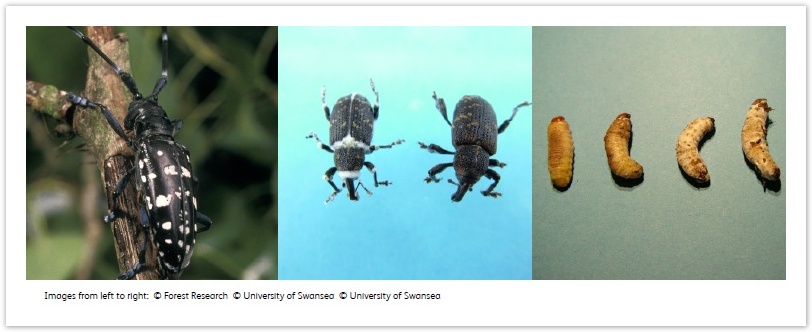Page History
Biological pest control of insect pests that threaten tree health - BIPESCO
Led by Professor Tariq Butt, Swansea University
A number of insects pose a threat to UK trees and plant biosecurity. The Tree Health and Plant Biosecurity Expert Taskforce set up by government recently recommended that the UK develops and implements ways to predict, monitor and control the spread of pests.
BIPESCO is an interdisciplinary project that will use botanicals and biocontrol with entomopathogenic fungi (EPF), fungi which kill or seriously disable insects, to kill and control insect pests that pose a threat to UK trees. BIPESCO will develop these natural alternatives to conventional chemical pesticides, of which usage is being severely restricted.
The aim of BIPESCO is to identify the strains of EPF that are most pathogenic to current and emergent pest species to utilise as efficient control, alongside botanicals that attract or repel target pests. The researchers will use botanicals to concentrate the pests and expose them to EPF and other agents in "lure and kill" and "stress and kill" strategies, increasing knowledge of the underlying mechanisms involved in control. BIPESCO’s outputs will offer environmentally friendly, sustainable methods of pest control, benefitting many sectors directly and indirectly.
Project website http://www.swansea.ac.uk/biosci/researchgroups/biocontrolandnaturalproductsgroup/banp/projects/lwecbipesco/
This project is in partnership with Fera and Forest Research (project participants).
Specific objectives (edited for this web site):
1. Evaluate the efficacy of selected strains of entomopathogenic fungi against Asian longhorned beetle and pine processionary moth. The two most virulent strains will be used for objectives 3-6.
2. Assess a range of botanicals for their attractant, repellent and pesticidal properties. Innovative methods will be used to identify the most efficacious compounds for use in studies to accomplish objectives 4-6.
3. Identify synergies between entomopathogenic fungi and botanicals – for use in lure/stress and kill strategy. Lure and kill will be demonstrated using pine weevil as a model. Stress and kill will be demonstrated using four target pests. Mechanisms linking stress with increased susceptibility will be investigated.
4. Determine compatibility of products and strategies under field conditions. Trials of botanicals and entomopathogenic fungi used alone and in combination.
5. Demonstrate the efficacy of the products and strategies to stakeholders. Field trials will be conducted to demonstrate to stakeholders the products and strategies and to generate data which will help accelerate registration of products.
6. Conduct risk assessment of products and strategies against non-target insects. Entomopathogenic fungi and botanicals selected for objectives 4 and 5 will be tested against several beneficial, non-target predators and parasitoids to assess any risk to these organisms.
7. Conduct cost-benefit analysis of products and strategies. A cost benefit analysis of the products and strategies will be conducted to enable stakeholders to make informed decisions on the negative and positive aspects of the new products and strategies.
Further Information
| Section | ||||||||||||||||||||||
|---|---|---|---|---|---|---|---|---|---|---|---|---|---|---|---|---|---|---|---|---|---|---|
| ||||||||||||||||||||||
|
